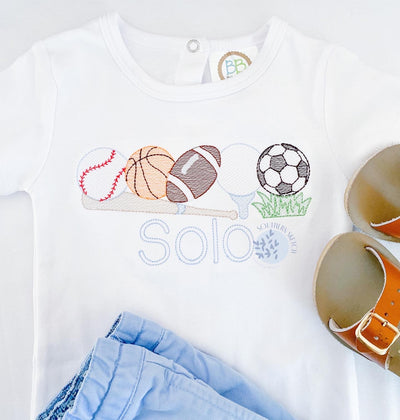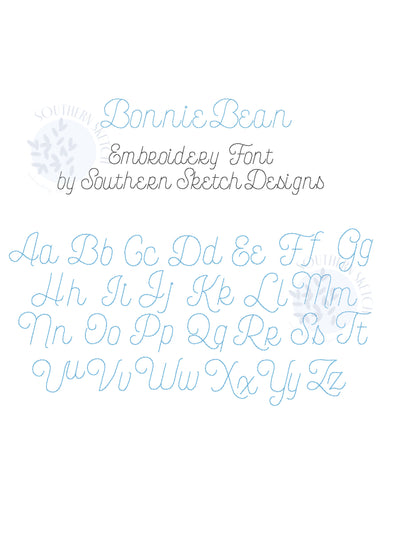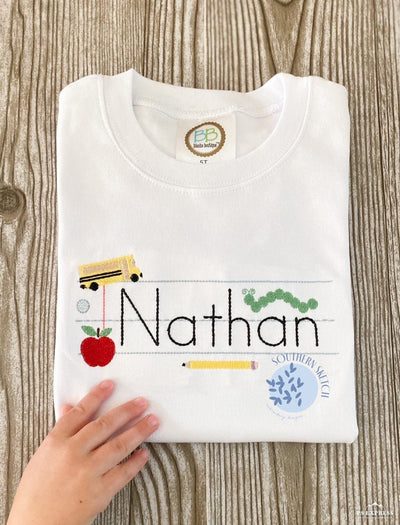Should I Start an Embroidery Business?

If you're reading this post, chances are you're looking for ways to make an extra income and wondering if starting your own embroidery business could be the right move. I, too, had this thought just a couple years ago shortly after finding out I was pregnant with my youngest that lead me to start my own online shop in the pockets of time I could find between my 9-5 job and raising small children. I am happy to share what I learned from my own experience.
Whether you're looking for a creative side gig or ready to hustle your craft into a full blown money maker, starting an embroidery business could be your perfect path! Machine embroidery is in high demand and can be quite lucrative. The best part, however, is that you can start your business with fairly low costs and out of the comfort of your home.
I frequently receive messages from women who are trying to figure out if buying an embroidery machine is right for them. Whether you are looking to pick up the trade as a business or a hobby, much of my advice is the same.
When I started, I so wish I had a friend who had already paved the way and could tell me point blank: What are the real costs? Can embroidery be a viable business? What all do I need to get started? What software do you use? What are some good learning resources?
Think of me as that friend for you. In this post, I'll do my best to answer as many of these questions as possible. I'll add links with my favorite software and supplies and share some great videos from some leaders in the business. If there are still questions left unanswered, ask them in the comments below and also please join our Facebook group: The Southern Sketch Embroidery Community.
As always, thank you for visiting Southern Sketch Designs. Let's jump right in!
Question: What machine do you use? Any advice on buying an embroidery machine?
Unfortunately, this isn't a black and white answer. To a friend I would simply say, I have a Brother Innovis 1150 and love it, but the Brother PE800 is a very popular starter machine and there are plenty of Youtube videos specifically on this machine, which is helpful. I bought mine on Facebook marketplace from a 14 year old boy who bought it to try and start a t-shirt business. Turns out, he was too intimidated to take it out of the box, and his mom made him sell it for half the price. I truly lucked out because, with the purchase, I also received the certificate to have it serviced from the place it was originally purchased. The most common advice I hear is to buy it from a certified retailer who will offer lessons and free servicing of your machine. That is wonderful advice and if you can take it - do it, but sometimes you luck out with a deal you can't refuse. This day and age you can learn anything on YouTube and chances are you can find someone to service your machine when needed for a pretty reasonable price in your area.
I also typically add that it was important for me, personally, to find a machine with more modern software. I thought it would make more sense to me as I was starting out. In addition, I wanted to make sure I could use at least a 5x7 hoop size. There are some entry level machines that only accommodate a 4x4 hoop (or a little larger) and I felt like I would outgrow that fast. For that very reason, many choose a multi-needle machine. This can be more intimidating starting out, but most agree they'd outgrow a single-needle machine.
Question: What software to you use? Do you like it?
I did a ton of research on this when I first started and I am so grateful that I finally decided on Embrilliance. Not only is it user friendly and intuitive, but there are more than enough resources out there to quickly learn how to use it. The more I get into embroidery, the more I realize that there are a lot of barriers for people who don't use this software. The greatest advantage of Embrilliance is that they offer and allow you to use what we call "native bx fonts." When you go to your software to add a name to a cute design for a bib, t-shirt, etc., you can easily use the fonts they offer or ones you've purchased online. You'll be able to type in the lettering you need and adjust its size with ease, all while never negatively affecting the stitching.
Embrilliance does have a free program that I only recommend to people on a temporary basis or if they spent too much money on a different software and aren't ready to fully switch yet. If someone is all in and ready to commit, I highly recommend Embrilliance Essentials. It's amazing and comes at a moderate fee that is worth its weight in gold. Plus, if you're starting a business, you'll make the money back in no time.
Question: Can I make money doing embroidery?
Simple answer is yes, because it is in such high demand. I keep up with the community, and women are constantly posting that they have to "close up shop to keep up with orders." When I first started, I thought I would NEVER close my shop. Turns out I did just that after only 3 months due to the number of orders I was receiving.
When I started, however, I wish I had a better grasp on the margins and the time it does take to make one individual item. Truthfully, it can be a grind. Not only do you have to consider the price of your machine and software, but there's also thread, bobbin thread, stabilizer, fabric for applique, spray adhesive, etc. These sometimes monthly expenses also factor into your net income.
When considering the time it takes to make a product, it's wise to also factor in the time it takes to consult with customers, create designs, and hoop or prepare your item. Some designs can even take an hour to stitch depending on the type and intricacy. Thankfully, that's not always the case, as most of my designs average about 15 minutes a piece. In addition to actually embroidering an item, you must factor cutting cross stitches (unless you have a machine that does it for you), photographing the design (if you're running an online business), and packaging/shipping.
Of course, there are ways to work more efficiently. I'll dive into more of those details at a later blog post, but one thing will always ring true. A multi-needle machine is always going to produce faster than a single-needle machine.
So, can you make money? Yes - good money. If you're looking for an extra side income, it's great! If you're looking for a way to work out of the home, this could be a successful path for you. Keep in mind, however, no matter how confident you are in your craft, it helps to be business savvy and know your way around social media.
I'll leave this section with an important tip I would give anyone looking to start a business: Practice...become really good and confident with what you make. Then, raise your prices. There are plenty of people who will have no issue paying top dollar for really good product, leading you to lower margins.
Question: What all do I need to get started?
Since you're a friend, I'm just going to tell you what I use, but a lot of this is personal preference. So, stick around for the next section. I'll give you the link to some awesome YouTubers, and you can also collect their perspective. Then, find what's best for you! Keep in mind, this is not a how-to post (which is on my blogging radar), so I won't go into depth on how to use these.
1. Stabilizer
Most often when making a routine children's shirt, I use one layer of medium cutaway stabilizer and call it a day. I've tried a bunch, but I am always happy with this brand. I baste it to the shirt with this simple spray adhesive, which you can also get at most crafting stores.
In some situations, I use one layer of fusible poly-mesh and one layer of medium tearaway. When I stitch linens or some specialty clothing, I use that same tear away. For sweatshirts, sweaters, and towels I use a layer of water soluble topper to keep the stitches laying nice and flat.
2. Thread
I choose to wind my own bobbins and use this thread, but prewound bobbins are also an option.
3. Iron and Ironing Board
One thing I did not foresee when starting my embroidery business is the amount of time I would spend ironing! I iron to prep applique fabric, occasionally for adding stabilizer, and always to make clothes look fresh and crisp before photographing them or sending them to customers.
I have a very basic iron, but it heats up quickly and I love it. Make sure you also buy iron cleaner so you never ruin a garment with a dirty iron. Then you might want some sort of compact ironing board so you don't take up too much space in your workshop especially if you are just focussing on children's clothes.
I was feeling crafty and made my own ironing board by going to Michaels and buying a small rectangular piece of plywood, cotton batting to make it plush, and fairly thick fabric. with the staple gun a secured the cotton batting to cover the front of the board and then did the same to cover it with fabric. It feels just like an ironing board, but its even easier to manipulate and move how I need it and is the perfect size for me.

4. Heat Bond Lite
Speaking of applique, when you're ready for that (try it, it's not as hard as it looks!), you're going to need some heat bond lite to prep the fabric before applying it to a shirt.
5. Scissors
Unfortunately, you won't have much luck grabbing the scissors from your kitchen junk drawer for high quality embroidery designs. I recommend snagging two pairs, and they're linked below!
Question: Did you know?
Many people don't realize when they first start embroidery that you can't adjust the size of the designs and fonts like you can in a word document. Designs are assigned specific stitches by the digitizer.

Lastly, I promised to link some great Youtube channels so you can binge watch some great embroiderers in action.
As I mentioned previously, make sure to leave a comment with any additional questions you may have. Want more from Southern Sketch Designs? Subscribe to my email list, and I will do my best to keep adding more posts based on your feedback!
Happy Stitching,
Margaret






Thank you so much for this! I bought my machine a while back but it was so hard with a 1 and 3 yr old. I also got discouraged because I could never center anything correctly. Any who my questions are what computer do you recommend I buy, and should I apply for a wholesale license in Texas so I can actually make more of a profit? Thank you again friend ❤️
Thx so much! I’ve just been doing projects for family but would love to make some money to help – plus I enjoy it so!
I feel like I’m so slow with design, thread colors, prepping the fabric, and on and on. I’m not sure how I’d make money. And input or advice?
Thank you for taking the time to write this!! So helpful as I get started myself.
This. Is. Gold. Thank you so much for sharing. Like you mentioned, you wish you had a friend to pave the path and tell you the nitty gritty. I’ve been paving my own path and finding out the hard way haha. I recently opened my basement business at the beginning of the year and so appreciate the expertise and knowledge you have provided! Looking forward to more posts/shares!
Maddie
You are a true gem! Thank you for sharing. I started a business with my daughter a year ago. We are slowly growing dreaming of a day that we have to turn away business 😂
Leave a comment